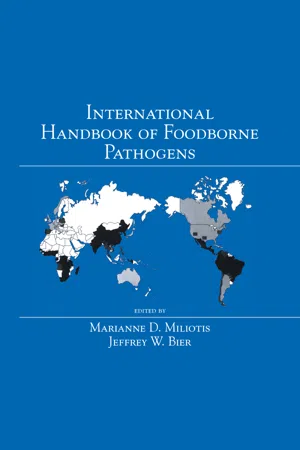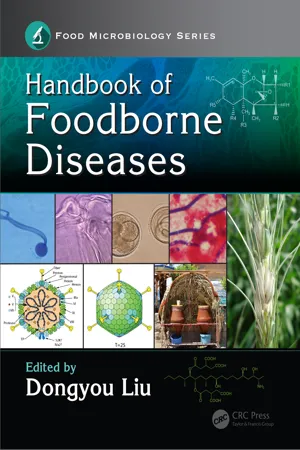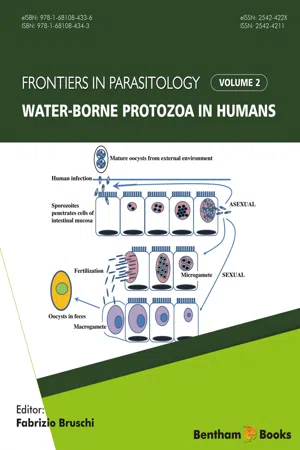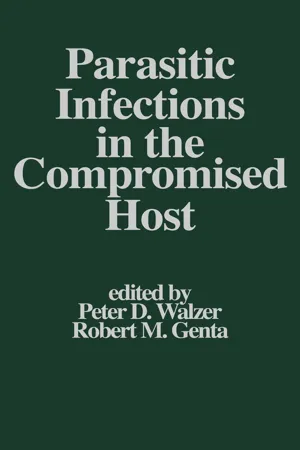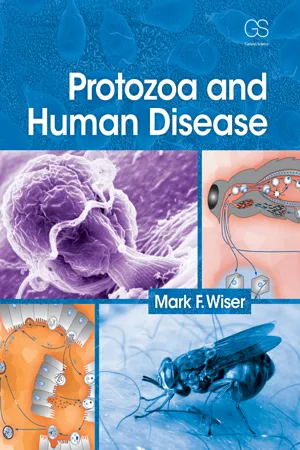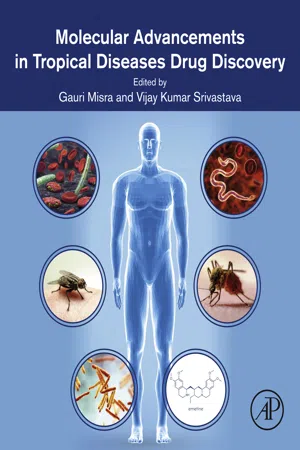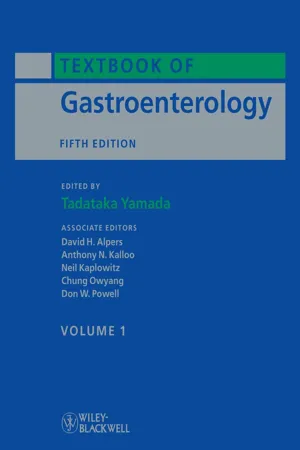Biological Sciences
Entamoeba Histolytica
Entamoeba histolytica is a parasitic amoeba known to cause amoebiasis, a potentially serious intestinal infection in humans. It is transmitted through ingestion of contaminated food or water. The amoeba can invade the intestinal wall, leading to symptoms such as diarrhea, abdominal pain, and in severe cases, liver abscesses. Proper sanitation and hygiene are crucial for prevention.
Written by Perlego with AI-assistance
10 Key excerpts on "Entamoeba Histolytica"
- eBook - ePub
- Marianne D. Miliotis, Jeffrey W. Bier(Authors)
- 2003(Publication Date)
- CRC Press(Publisher)
26
Entamoeba Histolytica
Terry F. H. G. Jackson and Selvan G. ReddySouth African Medical Research Council, Durban, South AfricaI. BACKGROUND
Entamoeba Histolytica is a protozoan parasite responsible for the disease amebiasis. Although the organism generally asymptomatically parasitizes the human gastrointestinal tract, it can invade the intestinal mucosa, giving rise to amebic dysentery, and in some cases it spreads to other organs, primarily the liver, where it causes amebic liver abscess. It is estimated that amebiasis is responsible globally for approximately 70,000 deaths per annum and is the fourth leading cause of death due to a protozoan infection after malaria, Chagas’ disease, and leishmaniasis (1 ).The first definite description of Entamoeba Histolytica can be attributed to Fedor Losch in 1875 (2 ). Lösch described the clinical and autopsy findings of a case of fatal dysentery in a Russian migrant laborer. He recorded detailed descriptions of the amebae found in the stool and intestinal ulcers. He described their size, varying shape, their biphasic cytoplasm, the presence of ingested foreign bodies, among which he recognized red blood corpuscles, the characteristics of the nucleus, and the peculiar movements of the organisms. He concluded that these amebae were different from those known at that time and decided that they were a new species for which he proposed the name Amoeba coli. Although he was able to successfully infect dogs using stools from the autopsy and observed ulcerative lesions similar to that found in the migrant, Lösch did not attribute any etiological significance to the presence of these amebae in stools and lesions. Over the next 30 years, several authors added to these observations:In 1891 Councilman and Lafleur (3 ) reported on detailed studies of lesions found in intestines and hepatic abscesses. They confirmed the pathogenic role of Amoeba coli - eBook - ePub
- Dongyou Liu(Author)
- 2018(Publication Date)
- CRC Press(Publisher)
It is estimated that E. histolytica causes 50 million cases of disease and 40,000–100,000 deaths per year 2 ; however, many aspects of the host-parasite relationship are still poorly understood. Intestinal amoebiasis (IA) affects the large intestine and is related to several clinical states. Amoebic ulcerative colitis is a well-defined medical infection, but other less common disorders include amoebic fulminating dysentery, amoeboma, and amoebic appendicitis. Amoebic liver abscess (ALA) is the most frequent extraintestinal form of amoebiasis and is characterized by large areas of liver necrosis or by abscesses. 3 As humans are the main sufferers of amoebiasis, it is essential to review aspects of the parasite’s cell biology and life cycle as well as clinical aspects and the epidemiology, pathogenesis, diagnosis, and treatment of this disease. Further knowledge of E. histolytica and of host responses of amoebiasis would help elucidate many aspects of this illness. In this chapter, we highlight the use of in vitro and in vivo models to understand the pathology and to facilitate more effective and earlier diagnosis. New protocols for the treatment of amoebiasis are needed to prevent side effects. 56.2 Morphology and Classification E. histolytica progresses through two different stages: a trophozoite or vegetative motile form (also called an amoeba) and a cyst, the resistant and infective form. 4 Cysts have been isolated from soil, food, and water, mainly in developing countries where poor hygienic conditions and lack of potable water access prevail (Figure 56.1). 2, 5 Figure 56.1 Morphology of E. histolytica. (a) Trophozoite (t) and cyst (c) from stool sample stained with Lugol (40 ×). (b) Axenic culture of trophozoites. The amoebae present pleomorphic morphology, a lobopod is seen (arrow) (40 ×). (c) Transmission electron microscopy of E. histolytica trophozoite. The nucleus (n) appears with their typical morphology; several vacuoles (v) are present in the cytoplasm - eBook - ePub
- Fabrizio Bruschi(Author)
- 2017(Publication Date)
- Bentham Science Publishers(Publisher)
Entamoeba Histolytica and other Pathogenic Intestinal AmoebeaIntroduction
Entamoeba Histolytica is an extracellular anaerobic parasitic enteric protozoan and the etiologic agent of amebic colitis and liver abscesses through water- and food-borne transmissions. Infection with E. histolytica, named amebiasis, affects up to 10% of the world’s population (approximately 500 million people worldwide) and is a major cause of symptomatic illnesses (50 million of persons/year) and death (100,000 persons/year). Although the incidence of amebiasis may be over-estimated by misdiagnosing pathogenic E. histolytica with non-pathogenic amoebas (e.g., E. dispar and E. moshkovskii), amebiasis is considered one of the major causes of death due to parasitic infections in developing countries, after malaria and schistosomiasis [1 ].History
Reports of people with bloody and mucous diarrhoea (probably amebiasis) were written 1000-600BC when Assyrian and Babylonian texts mentioned cases of dysentery in the Tigris-Euphrates basin [2 ]. By the 16th century, amebiasis was commonly described in developed Europe, mostly due to the growth of European colonies and increased world trade. At that time, there was a distinction of hepatic and intestinal forms of amebiasis. The first accurate description of both forms of the disease came from the book “Researches into the Causes, Nature and Treatment of the More Prevalent Diseases of India and of Warm Climates Generally” written by James Annersley in the 19th century [2 ]. With advances in microscopy, Friedrich Losch was the first to describe E. histolytica in Russia in 1873 from a young farmer who had been suffering from chronic dysentery [2 ]. In 1925, Emile Brumpt suggested that there must be two species: one that is invasive while the other is not (later named E. dispar) to explain why some people who were infected with E. histolytica (i.e. cysts in their stool) could never develop symptoms of the disease and spontaneously clear the infection [3 ]. However, it was not until the 1990’s, due to biochemical, immunological and genetic tools that E. histolytica was reclassified as an invasive species named E. histolytica and the non-invasive species named E. dispar [3 - eBook - ePub
- Peter D. Walzer, Robert M. Genta(Authors)
- 2020(Publication Date)
- CRC Press(Publisher)
3 ).Leonard Rogers reported successful treatment of three cases of amebiasis in Calcutta by injection with emetine (7 ). This marked the beginning of antiamebic chemotherapy, although the patients treated with emetine were later found to be prone to relapses with their infections (as emetine did not eliminate intraluminal infection). Cysts of E. histolytica but not of E. coli taken orally produced dysentery in human volunteer studies conducted in the Philippines by Walker and Sellards (8 ). Cultivation in vitro of histolytica was accomplished in 1925 by Boeck and Drbohlav; the cultured amebas caused dysentery in a kitten model of disease (9 ). Amebic trophozoites were found to encyst in Boeck's medium when rice starch was added by Dobell, who described the amebic life cycle (10 ). It was not until 1961 that the axenic (free of associated microorganisms) culture of E. histolytica was described by Diamond (11 ). Axenic culture of E. histolytica has directly contributed to the rapid increase in our knowledge of this parasite in the last 25 years.II. The OrganismA. Life Cycle and Epidemiology
It is important to distinguish the potentially highly virulent Entamoeba Histolytica from other enteric protozoans that are mostly nonpathogenic. There are eight species of amebas that have been shown to be enteric parasites in humans: Entamoeba Histolytica, E. hartmanni, E. coli, E. gingivalis, E. polecki, Endolimax nana, Dientamoeba fragilis, and Iodamoeba butschlii. All of these organisms, except E. gingivalis, which inhabits the mouth, can be isolated from human stool. These parasitic protozoans are distinguished by morphological criteria and by their pathogenicity for humans (12 ,13 ) (Fig. 1 ).Entamoeba gingivalis trophozoites have a cytoplasm full of dark staining bodies and food vacuoles. E. gingivalis is associated with poor dental hygiene and must be distinguished from E. histolytica in the sputum of patients with lung abscess. Entamoeba Histolytica trophozoites are large (12-60 μm), exhibit unidirectional motility, and can contain ingested erythrocytes. The cysts of E. histolytica contain up to four nuclei. The E. histolytica-like Laredo strain is nonpathogenic and grows optimally at 24°C in vitro, as opposed to an optimal growth temperature of 35°C for E. histolytica - eBook - ePub
- Mark F Wiser(Author)
- 2010(Publication Date)
- Garland Science(Publisher)
3Entamoeba and AmebiasisDisease(s) Amebiasis, amebic dysentery Etiological agent(s) Entamoeba HistolyticaMajor organ(s) affected Colon, liver Transmission mode or vector Fecal–oral Geographical distribution Worldwide, but more prevalent in tropical and developing countries Morbidity and mortality Generally asymptomatic or mild symptoms; severe symptoms include dysentery and spread to other organs that can be fatal Diagnosis Detection of parasites in feces Treatment Metronidazole Control and prevention Avoid fecal contamination of food or water Several members of the genus Entamoeba infect humans. Among these only E. histolytica is considered pathogenic and the disease it causes is called amebiasis or amebic dysentery. Humans are the only host of E. histolytica and there are no zoonotic reservoirs. E. dispar is morphologically identical to E. histolytica and the two were previously considered to be the same species. However, genetic and biochemical data clearly indicate that the nonpathogenic E. dispar is a distinct species. The two species are found throughout the world, but like many other intestinal protozoa, they are more common in tropical countries or other areas with poor sanitary conditions. High rates of amebiasis occur in the Indian subcontinent, the Far East, western and southern Africa, and parts of South and Central America. In the United States and Europe amebiasis is found primarily in immigrants from endemic areas. It is estimated that up to 10% of the world’s population may be infected with either E. histolytica or E. dispar (or both) and in many tropical countries the prevalence may approach 50%. There are an estimated 50 million clinical cases of amebiasis per year with up to 100 000 deaths.Life Cycle and Morphology
E. histolytica exhibits a typical fecal–oral life cycle consisting of infectious cysts passed in the feces and trophozoites which replicate within the large intestine. The infection is acquired through the ingestion of cysts and the risk factors are similar to other diseases transmitted by the fecal–oral route (see Chapter 2 ). Contaminated food and water are probably the primary sources of infection. The higher prevalence in areas of lower socioeconomic status is likely due to poor sanitation and a lack of indoor plumbing. However, E. histolytica is rarely the cause of travelers’ diarrhea and is usually associated with long-term (>1 month) stays in an endemic area. A higher prevalence of E. histolytica - eBook - ePub
- Lynne Shore Garcia(Author)
- 2016(Publication Date)
- ASM Press(Publisher)
21 Intestinal Protozoa: Amebae Entamoeba Histolytica Entamoeba dispar Entamoeba moshkovskii Entamoeba bangladeshi Entamoeba hartmanni Entamoeba coli Entamoeba polecki Entamoeba gingivalis Endolimax nana Iodamoeba bütschliiBlastocystis spp.Entamoeba HistolyticaEntamoeba Histolytica was first described by Losch after it was isolated in Russia from a patient with dysenteric stools. Although Losch found the organisms in human colonic ulcers at autopsy and was able to induce dysentery in a dog that was inoculated rectally with the patient’s stools, he failed to recognize the causal relationship. This organism was eventually more fully investigated and differentiated from Entamoeba coli and Entamoeba hartmanni with respect to both morphology and pathogenesis (1 ). Based on the genome, this organism has a number of metabolic adaptations shared with two other amitochondrial protist pathogens, Giardia lamblia and Trichomonas vaginalis . These adaptations include the use of oxidative stress enzymes usually associated with anaerobic prokaryotes, as well as reduction or elimination of most mitochondrial metabolic pathways. There is evidence for lateral gene transfer of bacterial genes into the E. histolytica genome, a large number of novel receptor kinases, and expansions of a variety of gene families, including those associated with virulence (2 ).E. histolytica has been recovered worldwide and is more prevalent in the tropics and subtropics than in cooler climates. However, infection rates in unsanitary conditions in temperate and colder climates have been found to equal those seen in the tropics. The World Health Organization reported that E. histolytica causes approximately 50 million cases and 110,000 deaths annually (3 ). Only malaria and schistosomiasis surpass amebiasis as leading parasitic causes of death.At least 11 amebae are found in the mouth or intestinal lumen (E. histolytica , Entamoeba dispar , Entamoeba moshkovskii , Entamoeba bangladeshi , E. hartmanni , E. coli , Entamoeba polecki , Entamoeba gingivalis , Endolimax nana , Iodamoeba bütschlii - Gauri Misra, Vijay Kumar Srivastava(Authors)
- 2020(Publication Date)
- Academic Press(Publisher)
Chapter 1Amebiasis
Nurulhasanah Othman, Jorim Anak Ujang, Yee Ling Ng, Gaayathri Kumarasamy, and Rahmah Noordin Institute for Research in Molecular Medicine (INFORMM), Universiti Sains Malaysia, Gelugor, Penang, MalaysiaAbstract
Amebiasis is caused by Entamoeba Histolytica that remains a global health burden mainly in developing countries despite advancements in neglected tropical disease control programs by WHO. Patients with symptomatic amebiasis commonly present with amebic colitis and amebic liver abscess though most infected individuals are asymptomatic. The latter is the reservoir of this protozoan parasite and eventually causes the disease transmission. Therefore the new strategy in developing drugs and vaccines that can block disease transmission is important because only a few drugs are available in the market and the absence of effective vaccines to combat amebiasis. To accomplish that, a new diagnostic tool that can differentiate E . histolytica infection stages and nonpathogenic Entamoeba would be highly recommended.Keywords
Amoebiasis; Drug; Molecular pathway; Vaccine1.1. Introduction
1.1.1. History
Amebiasis was first reported as a deadly disease in 1873 by Hippocrates who examined a patient suffering from bloody dysentery [1 ]. Two years later, Entamoeba Histolytica trophozoite was identified by Fedor Aleksondrovich Losch in a farmer who suffered from a fatal case of dysentery [2 ]. Further investigation by inoculating the stool of the patient into the rectum of a dog caused a similar manifestation [2 ]. A significant milestone was achieved with the characterization of E . histolytica as the causative agent for amebic colitis and amebic liver abscess (ALA) in the 1890s by Sir William Olser and his colleagues [1 ]. Subsequently, the identification of cyst as an infectious stage was confirmed by Walker and Sellards in 1913 and followed by the establishment of the E . histolytica life cycle by Dobell in 1925 [1 ]. In 1997, amebiasis was ranked second as death-causing parasitic infection, after malaria [3 ]. Approximately 40,000–100,000 deaths occurred annually, which include 1.9%–9% of amebic colitis patients [4- eBook - ePub
Sexually Transmitted Diseases
Epidemiology, Pathology, Diagnosis, and Treatment
- Kenneth A. Borchardt, Michael A. Noble(Authors)
- 2023(Publication Date)
- CRC Press(Publisher)
21 The galactose-specific adhesin is a possible candidate for a vaccine. It is antigenically conserved and has a high-affinity interaction with galactose-terminal colonic mucin glycoproteins which are thought to be important prerequisites for colonization. A number of other potential protective antigens are being investigated; hopefully, one of these options will prove to be the key to the development of a cost-effective vaccine for the reduction or elimination of amebiasis as a human disease.9.3 Life cycle and morphology
The life cycle is seen in Figure 1 . The cyst form is the infective form for humans.Figure 1 Life cycle of Entamoeba Histolytica.(Adapted from Garcia, L.S. and D.A. Bruckner, Diagnostic Medical Parasitology, 3rd ed. American Society for Microbiology, ASM Press, Washington, D.C., 1997. With permission.)9.3.1 Morphology of trophozoite
Living trophozoites vary in size from about 10 to 60 μm in diameter and may be confused with other organisms (Table 1 ). Organisms recovered from diarrheic or dysenteric stools are generally larger than those in a formed stool from an asymptomatic individual (Figures 2 –4 ). The motility has been described as rapid and unidirectional with pseudopods forming quickly in response to the conditions around the organism. The motility may appear to be sporadic. Although this characteristic motility is often described, it is rare to diagnose amebiasis on the basis of motility seen in a direct wet mount. The cytoplasm is differentiated into a clear outer ectoplasm with a more granular inner endoplasm.Figure 2 E. histolytica trophozoite (top) and cyst (bottom); note identifying morphologic characteristics.Figure 3 E. histolytica - eBook - ePub
- Tadataka Yamada(Author)
- 2011(Publication Date)
- Wiley-Blackwell(Publisher)
Entamoeba Histolytica . NewYork: John Wiley & Sons, 1988:129.20. Tsutsumi V. Pathology of experimental amebiasis. In: Ravdin JI(ed.). Amebiasis: Human Infection by Entamoeba Histolytica. NewYork: John Wiley & Sons, 1988:147.21. McCoy JJ, Mann BJ, Petri WA Jr. Adherence and cytotoxicity of Entamoeba Histolytica or how lectins let parasites stick around. Infect Immun 1994;62:3045.22. Keene WE, Hidalgo ME, Orozco E, et al. Entamoeba Histolytica: correlation of the cytopathic effect of virulent trophozoites with secretion of a cysteine proteinase. Exp Parasitol 1990;71:199.23. McLaughlin J, Faubert G. Partial purification and some properties of a neutral sulfhydryl and an acid proteinase from Entamoeba Histolytica . Can J Microbiol 1977;23:420.24. Tannich E, Scholze H, Nickel R, et al. Homologous cysteine proteinases of pathogenic and nonpathogenic Entamoeba Histolytica . Differences in structure and expression. J Biol Chem 1991;266:4798.25. Stanley SL Jr, Zhang T, Rubin D, et al. Role of the Entamoeba Histolytica cysteine proteinase in amebic liver abscess formation in severecombined immunodeficient (SCID) mice. Infect Immun 1995;63:1587.26. Zhang Z, Yan L, Wang L, et al. Entamoeba Histolytica cysteine proteinases with interleukin-1 beta converting enzyme activity causeintestinal inflammation and tissue damage in amoebiasis. Mol Microbiol 2000;37:542.27. Leippe M, Ebel S, Schoenberger OL, et al. Pore-forming peptide of pathogenic Entamoeba Histolytica . Proc Natl Acad Sci U S A 1991;88:7659.28. Leippe M. Amoebapores. Parasitol Today 1997;13:178.29. Labruyere E, Guillen N. Host tissue invasion by Entamoeba Histolytica is powered by motility and phagocytosis. Arch Med Res 2006;37:253.30. Okada M, Nozaki T. New insights into molecular mechanisms of phagocytosis in Entamoeba Histolytica by proteomic analysis. Arch Med Res 2006;37:244.31. Loftus B, Anderson I, Davies R, et al. The genome of the protist parasite Entamoeba Histolytica , Nature 2005;433:865.32. Ramesh MA, Malik S-B, Logsdon JM. A phylogenetic inventory of meiotic genes evidence for sex in Giardia - eBook - ePub
Biology for the Health Sciences
Mechanisms of Disease
- Mark F Wiser(Author)
- 2023(Publication Date)
- Garland Science(Publisher)
E. histolytica infections can range from asymptomatic to death. The disease is often characterized as being either non-invasive or invasive. During non-invasive disease the trophozoites establish a colony of amoeba in the colon and exhibit the typical fecal–oral life cycle. The trophozoites ingest bacteria and fecal matter as a food source and replicate by mitosis. The non-invasive disease is often asymptomatic or associated with diarrhea and other gastrointestinal symptoms such as cramping or pain. Most infections do not exhibit severe clinical manifestations and self-resolve in weeks to months.However, the infection can progress to severe invasive disease (FIGURE 21.13 ). E. histolytica trophozoites can kill intestinal epithelial cells resulting in the formation of colonic ulcers that cause colitis and dysentery. The lesions can expand through the submucosa and occasionally through the colon wall leading to a perforation of the colon wall and peritonitis. In addition, the trophozoites in the submucosa can enter the circulatory system and metastasize throughout the body and cause extra-intestinal amebiasis. Since the mesentery blood vessels and portal vein system go directly from the intestines to the liver, the liver is the most common site of extra-intestinal amebiasis. From the liver the trophozoites can continue spreading throughout the body and affecting other organs. The pathology associated with amebiasis is due to a contact-dependent killing of host cells by the trophozoites. Severe diseases, such as fulminant amoebic colitis, peritonitis, or extra-intestinal amebiasis can be mortal if not treated.FIGURE 21.13Non-invasive versus invasive amebiasis. During non-invasive disease the trophozoites of E. histolytica form a colony on the mucosa of the large intestine and exhibit a typical fecal–oral life cycle. Invasion of the epithelial layer of the colon by trophozoites results in ulcers and colitis. Trophozoites in the submucosa can enter the portal vein system and travel to the liver and other organs, such as the lung. The lesion can also expand and perforate the colon wall leading to peritonitis or trophozoites can spread to the genitalia. [Adapted from Wiser MF (2021) Nutrition and protozoan pathogens of humans: a primer. In Humphries DL, Scott ME and Vermund SH (eds), Nutrition and infectious diseases. Nutrition and Health
Index pages curate the most relevant extracts from our library of academic textbooks. They’ve been created using an in-house natural language model (NLM), each adding context and meaning to key research topics.
Explore more topic indexes
Explore more topic indexes
1 of 6
Explore more topic indexes
1 of 4
